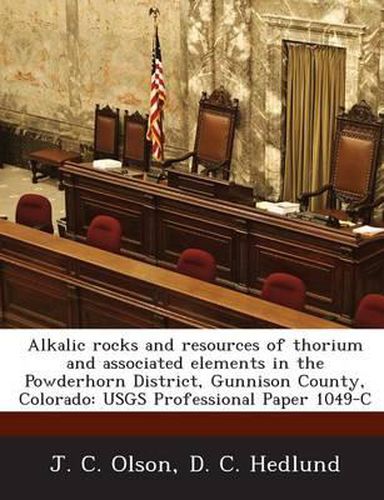Alkalic Rocks and Resources of Thorium and Associated Elements in the Powderhorn District, Gunnison County, Colorado
J C Olson,D C Hedlund

Alkalic Rocks and Resources of Thorium and Associated Elements in the Powderhorn District, Gunnison County, Colorado
J C Olson,D C Hedlund
Alkalic igneous rocks and related concentrations of thorium, niobium, rare-earth elements, titanium, and other elements have long been known in the Powderhorn mining district and have been explored intermittently for several decades. The deposits formed chiefly about 570 m.y. (million years) ago in latest Precambrian or Early Cambrian time. They were emplaced in lower Proterozoic (Proterozoic X) metasedimentary, metavolcanic, and plutonic rocks. The complex of alkalic rocks of Iron Hill occupies 31 km 2 (square kilometers) and is composed of pyroxenite, uncompahgrite, ijolite, nepheline syenite, and carbonatite, in order of generally decreasing age. Fenite occurs in a zone, in places more than 0.6 km (kilometer) wide, around a large part of the margin of the complex and adjacent to alkalic dikes intruding Precambrian host rock. The alkalic rocks have a radioactivity, chiefly due to thorium, greater than that of the surrounding Powderhorn Granite (Proterozoic X) and metamorphic rocks. The pyroxenite, uncompahgrite, ijolite, and nepheline syenite, which form more than 80 percent of the complex, have fairly uniform radioactivity. Radioactivity in the carbonatite stock, carbonatite dikes, and the carbonatite-pyroxenite mixed rock zone, however, generally exceeds that in the other rocks of the complex. The thorium concentrations in the Powderhorn district occur in six types of deposits: thorite veins, a large massive carbonatite body, carbonatite dikes, trachyte dikes, magnetite-ilmeniteperovskite dikes or segregations, and disseminations in small, anomalously radioactive plutons chiefly of granite or quartz syenite that are older than rocks of the alkalic complex. The highest grade thorium concentrations in the district are in veins that commonly occur in steeply dipping, crosscutting shear or breccia zones in the Precambrian rocks. They range in thickness from a centimeter or less to 5 m (meters) and are as much as 1 km long. The thorite veins are composed chiefly of potassic feldspar, white to smoky quartz, calcite, barite, goethite, and hematite, and also contain thorite, jasper, magnetite, pyrite, galena, chalcopyrite, sphalerite, synchysite, apatite, fluorite, biotite, sodic amphibole, rutile, monazite, bastnaesite, and vanadinite.
This item is not currently in-stock. It can be ordered online and is expected to ship in approx 2 weeks
Our stock data is updated periodically, and availability may change throughout the day for in-demand items. Please call the relevant shop for the most current stock information. Prices are subject to change without notice.
Sign in or become a Readings Member to add this title to a wishlist.


